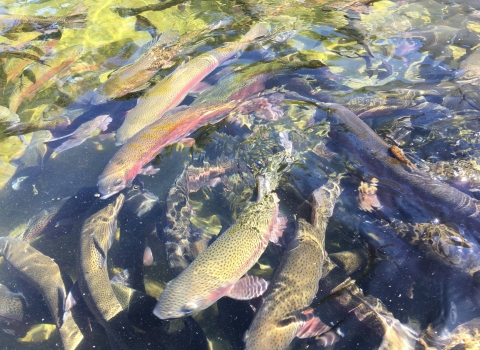The U.S. Fish and Wildlife Service today announced nearly $13 million in competitive funding for 17 State fish and wildlife agencies under the Landowner Incentive Program. The program supports cooperative efforts with private landowners interested in conserving natural habitat for species at risk, including federally listed endangered or threatened species and proposed or candidate species.
The Arizona Game and Fish Department will receive $849,510 to enhance, restore and protect habitat on private lands for endangered, threatened, candidate species and species of concern.
The Department will focus its efforts on two habitat types, grasslands and riparian riparian
Definition of riparian habitat or riparian areas.
Learn more about riparian . Examples of grassland species are the Ferruginous hawk, Western burrowing owl, and the Black footed ferret. The types of activities that will be carried out for these species are 1) securing wildlife conservation easements, 2) controlling and removing invasive species invasive species
An invasive species is any plant or animal that has spread or been introduced into a new area where they are, or could, cause harm to the environment, economy, or human, animal, or plant health. Their unwelcome presence can destroy ecosystems and cost millions of dollars.
Learn more about invasive species , 3) reseeding native grasses, and 4) fencing for sustainable livestock management. Examples of riparian species are Chiricahua leopard frog, Southwestern willow flycatcher, Gila chub, Gila Topminnow, Little Colorado spinedace and spikedace. The activities that the department plans that will benefit riparian species are 1) controlling invasive species, 2) planting native riparian vegetation, 3) restoring ponds and wetlands and 4) constructing species refugia. Benefits to the targeted species include improved foraging, breeding, brood rearing and nesting habitats, decreased competition and predation, and increased prey base.
Arizonas Comprehensive Wildlife Conservation Strategy identified both types as habitats of greatest conservation need. The Department identified 36 species of greatest conservation need that would benefit from the enhancement, protection or restoration of grassland habitat and 88 species of greatest conservation need that would benefit by the enhancement, protection, or restoration of riparian habitat.
The competitive grants are funded through the Land and Water Conservation Fund and establish or supplement existing landowner incentive programs that provide technical or financial assistance to private landowners. All grants need to be matched by funding of at least 25 percent from a non-Federal source.
For more information about the grant programs, please visit >http://federalaid.fws.gov/lip/lip.html. The Catalog of Federal Domestic Assistance reference number is 15.633.
The Landowner Incentive Program will not be funded next year. While cooperative conservation remains a significant part of the Services efforts, recent evaluations have indicated that this program is duplicative of other programs. At-risk species will benefit by shifting resources from this program to others that can demonstrate results such as the National Wildlife Refuge System, Partners for Fish and Wildlife Program and the North American Wetlands Conservation Act programs.


